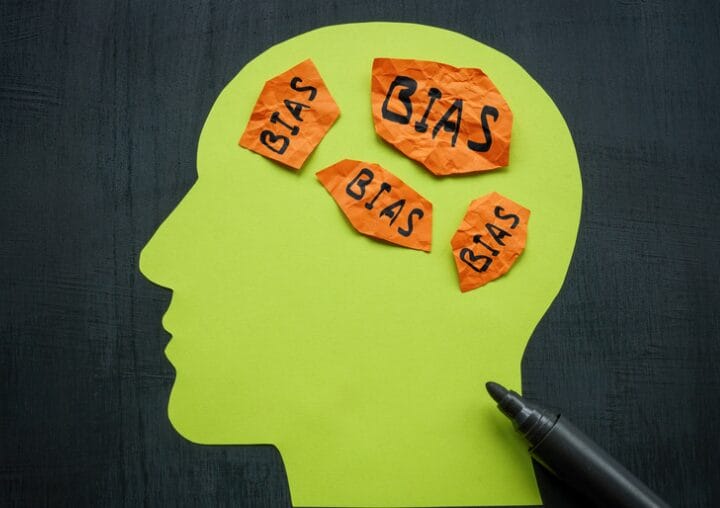We’re in control after all!
We have long been told that the majority of actions, decisions and behaviors are driven by our unconscious mind – the ‘hidden’ part of us where our attitudes, beliefs and biases reside. A new book has turned this concept on its head – literally turning Freud’s iceberg upside-down to illustrate that the majority of our existence is conscious – and we have access and control. Doing otherwise is an abdication of responsibility says Professor Ben Newell, who, along with Professor David Shanks, is the author of Open Minded: Searching for Truth about the Unconscious Mind.
Professor Newell’s research challenges the idea that unconscious processes play a dominant role in decision-making and behaviors. Historically, research has likened ‘priming’ – the exposure to stimulus that has a subsequent influence on decision-making or behavior without us realizing – like a boulder crash landing in water. Newell, however, compares it to a pebble creating small ripples of influence where we make connections between concepts and create brain hacks like stereotypes so that we can effectively process information. Granted, distinguishing between conscious and unconscious decision-making can be challenging, as the two processes often interact and influence each other but by deliberate thinking, weighing options and justification of the decision, we can be more confident that we are not subject to an unconscious process.
Instead of the ‘abdication of responsibility’ that Newell believes the unconscious bias narrative supports, he advocates for careful reasoning and conscious deliberation. Both working together to achieve the best outcomes.
If leaders were to take more responsibility for conscious behaviors and decision-making, it would involve several actionable changes in their approach:
- Encouraging deliberate thinking: Leaders should create an environment that values and promotes deliberate, conscious thought processes. This might involve providing team members with the time and resources needed to carefully consider problems, gather relevant information, and weigh potential solutions before making decisions.
- Fostering self-awareness: Leaders should cultivate their own self-awareness and encourage team members to do the same. This involves recognizing and understanding one’s own thought processes, biases, and emotions, and how they influence decision-making. Leaders can promote self-awareness through reflective practices, such as journaling, discussing decision-making processes, and seeking feedback.
- Emphasizing evidence-based decision-making: Leaders should prioritize evidence-based decision-making, encouraging team members to base their choices on objective data, research, and rational analysis rather than solely relying on intuition or unconscious biases.
- Promoting critical thinking: Leaders should foster a culture of critical thinking, where team members are encouraged to question assumptions, consider alternative perspectives, and engage in robust discussions before reaching conclusions. This can be achieved through training programs, workshops, and modeling critical thinking behaviors.
- Encouraging transparency: Leaders should be transparent about their own decision-making processes and encourage team members to do the same. By openly discussing the reasoning behind choices and the factors considered, leaders can promote accountability and encourage more conscious, deliberate decision-making.
- Creating opportunities for reflection: Leaders should provide opportunities for team members to reflect on their decision-making processes and outcomes. This can involve post-project reviews, debriefs, or regular check-ins to discuss what worked well, what could be improved, and what lessons can be learned for future decisions.
- Rewarding conscious decision-making: Leaders should recognize and reward team members who engage in conscious, deliberate decision-making processes, even if the outcomes are not always perfect. This reinforces the value placed on conscious thought and encourages others to adopt similar practices.
- Leading by example: Leaders should model the behaviors they wish to see in their team members. By engaging in conscious, deliberate decision-making themselves and being open about their thought processes, leaders can set a powerful example for their team to follow.
By implementing these practices, leaders can create an environment that values and promotes conscious, responsible decision-making, ultimately leading to better outcomes for their teams and organizations. It’s not about ignoring the role of intuition or experience but rather balancing these factors with conscious, deliberate thought processes to optimize decision-making.
A note on AI and bias
We asked Claude, an AI Assistant from Anthropic, to summarize the potential pitfalls of using AI in decision making.
When using AI to make decisions, there are several potential bias pitfalls that leaders should be aware of:
- Data bias: AI systems learn from the data they are trained on. If the training data is biased, the AI will inherit and potentially amplify those biases.
- Algorithmic bias: If the algorithms are designed with certain assumptions or priorities, they may systematically favor certain outcomes or groups over others.
- Lack of transparency: Many AI systems, particularly those based on deep learning, operate as “black boxes,” where the decision-making process is not easily interpretable or explainable. Feedback loops: If an AI system’s decisions are used to generate new data that is then fed back into the system for training, it can create a feedback loop that reinforces and amplifies existing biases over time.
- Underrepresentation: If certain groups or perspectives are underrepresented in the data used to train an AI system, the system may not accurately reflect or serve those groups. This can lead to biased outcomes that disadvantage or exclude underrepresented populations.
- Confirmation bias: If AI systems are designed to optimize for certain metrics or outcomes, they may inadvertently confirm existing biases or assumptions rather than challenging them.
- Lack of context: AI systems may struggle to account for the full context and nuance of complex decision-making scenarios. Without considering the broader social, cultural, and ethical implications of decisions, AI systems may make choices that are biased or harmful in ways that may not be immediately apparent.






